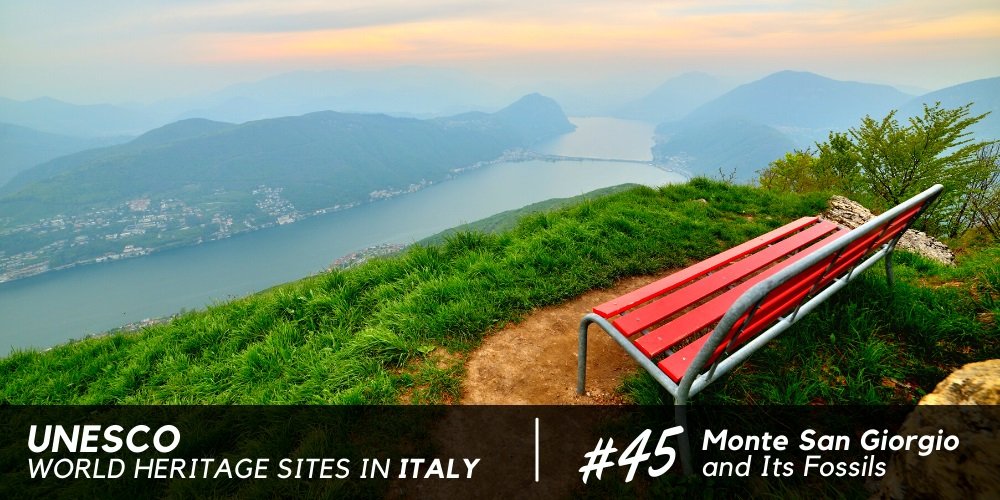Get ready to discover an ancient and exciting place that will make you feel like a child in a short time. You will go on an adventure searching for dinosaur fossils, discover paths, lagoons from the Tarsus era, magmatic rocks, limestone quarries and abandoned mines. This article will tell you the story of Monte San Giorgio, how it became a UNESCO World Heritage Site in two states, and give you some helpful travel tips for exploring this exciting Palaeolithic treasure.

If fossils are the remains of ancient organisms or traces of their existence, i.e. if these remains that have come down to us are the remains of animals and plants that were once actually alive, palaeontology - the science that studies these objects - becomes a science of life, just like biology, and must treat fossils as if they were actual organisms.
Monte San Giorgio
.jpg)
Monte San Giorgio view
Monte San Giorgio is an imposing relief overlooking Lake Lugano, between Lombardy and Switzerland. The landscape from the summit is breathtaking: it is a natural balcony overlooking most of the western Italian Alps and the Turin plain below, which stretches as far as the eye can see.
The pastures cover Monte San Giorgio and the surrounding Nature Park, and woods are scarce. The predominant colours are green, given not only by the vegetation but also by the green stones and metamorphic rocks, and red, given by the iron oxides, especially in the quarries and mines.
It seems incredible that this typically mountainous landscape could host a lagoon rich in fish, a tropical environment and even a coral reef!
Monte San Giorgio is a unique place: there are other important fossiliferous areas in the world, but none of this is significant in terms of marine life. Thanks to the treasures embedded in the rock of Monte San Giorgio, it has been possible to establish the evolution of climate and life in the region for over 15 million years.
Let's take a look at how this data caught the attention of the UNESCO World Heritage Committee.
A Unesco Heritage Site for two nations
.jpg)
italian and swiss sides of monte san giorgio
As mentioned earlier, the fossils of Monte San Giorgio are the essential evidence of marine life from the Triassic period: their discovery has made it possible to study the evolution of marine species concerning climate change.
Recognition of the paleontological value of the area dates back to the mid-19th century, and in 1862 the first research and analysis activities began. In 2003, the Triassic outcrops on the Swiss side of the mountain were inscribed on the UNESCO World Heritage List. In 2010, Monte San Giorgio was also recognised as a UNESCO World Heritage Site on Italian territory.
Inclusion on the list is officially motivated by Criterion VIII: Monte San Giorgio is the single best known record of marine life in the Triassic period, and records important remains of life on land as well. The property has produced diverse and numerous fossils, many of which show exceptional completeness and detailed preservation. The long history of study of the property and the disciplined management of the resource have created a well documented and catalogued body of specimens of exceptional quality, and are the basis for a rich associated geological literature. As a result, Monte San Giorgio provides the principal point of reference, relevant to future discoveries of marine Triassic remains throughout the world.
These fragments of natural elements, bits of stone, fossils, splinters of wood, things martyred by the elements, picked up along the edge of the sea, [...] expressing physical laws, wear, erosion, bursting, etc., not only have sculptural qualities, but also an extraordinary poetic potential.
Fossil Fauna and Flora
.jpg)
Monte San Giorgio fossil
A highly diverse marine life developed within the tropical lagoon of Monte San Giorgio: fish, crustaceans, ammonites and aquatic plants are just a few examples. The stagnant and oxygen-poor seabed created a favourable environment for preserving marine fossils.
However, the proximity to land has enriched the scenery with numerous terrestrial fossils: reptiles, insects, plants, and the skeleton of an archosaur called Ticinosuchus.
Some 21,000 fossils have been found, including 30 species of reptiles, 80 species of fish and around 100 species of invertebrates. Some fossil skeletons reach a length of 6 metres, such as the Sangiorgiosaurus or Ceresiosaurus.
The more than 50 finds of fossil flora found in the vicinity of the lagoon bear witness to the existence of terrestrial life: these are mainly conifers. Another element supporting the presence of terrestrial and aquatic life is the presence of several insect fossils: beetles, dragonflies and freshwater mosquitoes.
The mountain provides the framework, it is up to us to invent the story that goes with it.
Geo-paleontological trail
But reading about these fantastic finds is not enough: wouldn't you like to be on the trail of this lost world yourself? Wouldn't you want to discover the signs of this fascinating and mysterious prehistoric life on the rocks?
A circular educational trail has been created to help you trace the palaeological history of the region. So you can discover all the truly unmissable beauties of Monte San Giorgio.
The starting point is in the enchanting village of Meride, where a visit to the Fossil Museum is a must. Continue towards the hamlets of Fontana, Spinirolo and Crocefisso. From here, you can take the road that leads to the Brusino Arsizio cable car, which will take you to higher altitudes. Once you arrive at the Serpiano station, continue on foot along a slightly uphill path that will take you to an ancient alpine pasture surrounded by centuries-old chestnut trees: the Alpe di Brusino at 670m, where you can rest in an ancient cave.
From here, the path continues first in the direction of Gaggio and then towards Pozzo: once there, you will descend to Albertina and then back to Meride from where you began your journey.
A series of explanatory panels along the way will help you to learn about the history of this extraordinary place.
The best museums for Monte San Giorgio fossils
.jpg)
After this fascinating hike through the ancient alpine pastures, we suggest you visit the museums that house the most spectacular fossils extracted from Monte San Giorgio.
The Besano Museum is located in the heart of the village of the same name, in an early 20th-century building. Inside you will find a reception area, an area for educational workshops and a bookshop.
The Besano Museum exhibits a significant part of the finds from the area: you will find beautiful ammonites, bizarrely shaped fish and reptiles, the huge Besanosaurus (a giant reptile) and an almost 6-metre long ichthyosaur. The 'highlight' is the remains of a Saltriosaurus, the only skeleton of a carnivorous dinosaur found in Italy.
The Monte San Giorgio Fossil Museum in Merida is the starting point for the palaeology trail and a unique place to discover everything there is to know about the fossils of Monte San Giorgio. The museum was renovated and extended in 2012 and is spread over four floors.
On the ground floor is the visitor centre.
On the first floor, you will find the oldest fossils from the first excavation campaigns, models of giant marine reptiles, short films projected on a large screen and the immersive augmented reality experience Triassic Park.
On the second floor, the history of the region, especially mining history, is explored. The third floor displays fossils from Jurassic rocks that are 40 million years younger than those on the first floor, where you can also experience the augmented reality of a Triassic aquarium.
Interested in finding out more about Unesco sites in Italy? Discover our complete guide to all Unesco sites in Italy, region by region!
About the author
Written on 30/12/2021



.jpg)
Gloria Venturini
Monte San Giorgio is a truly amazing UNESCO site: a tropical lagoon rich in fossils dating back 250 million years!